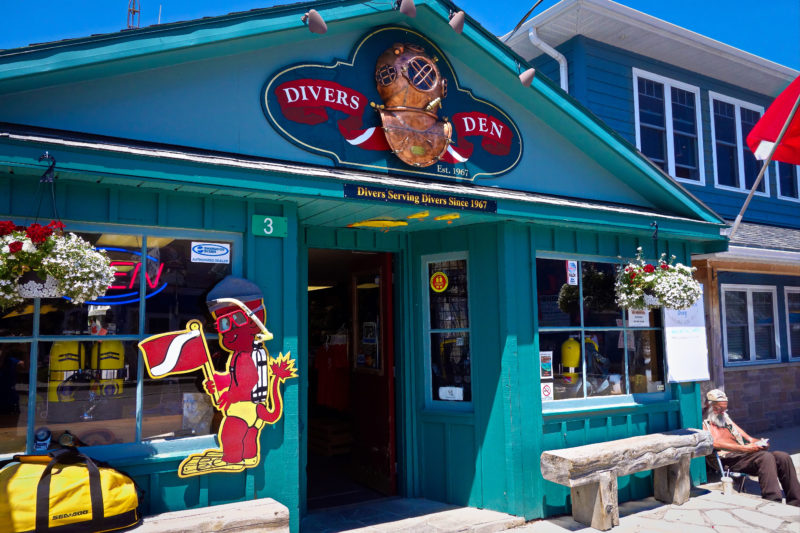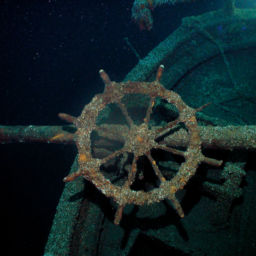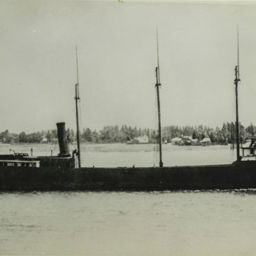Scuba diving in Tobermory, Ontario has been popular for over 50 years. The area, along with most of the Great Lakes, has plentiful wrecks, good visibility, and — shall we say — “refreshing” water temperatures. In June, I ventured north to check out Tobermory’s famous wrecks with Diver’s Den, which was celebrating its 50th anniversary serving divers on Lake Huron.
Scuba Diving in Tobermory with Diver’s Den
Diver’s Den has a great selection of new rental gear. This came in handy since I needed a few things despite my meticulous packing. Each of their five boats is huge as far as dive boats go, with interior areas to get out of the wind if needed or to change clothes. They all also have clean heads and brand- new AEDs. While we all hope to never need the latter, the former is something I frequently need on a dive boat, but rarely ever have. Drinking water is available but bring your own cup or reusable water bottle.
By far the best feature on their boats is Captain John, a sort of mash-up of boat captains you’ve seen in movies, with a subtle flair, dry humor, and a working knowledge of the history of the wrecks that would rival the Smithsonian. That he pilots you safely through Lake Huron will come second to his amazing storytelling. Learning about how the boats lived and died (so to speak) adds another dimension to the vessels you’re about to explore.
Speaking of wrecks, let’s get to them. I didn’t have nearly enough time to explore the 20-plus wrecks in Tobermory, but here’s a rundown of what I saw in Fathom Five National Marine Park.
Wetmore
The Wetmore was a steamer that ran aground in 1901 while towing barges across the lake. It sits in 25 feet (7 m), which makes it a great snorkeling spot too. It’s 213 feet (65 m) long and, while the main wooden structure is no longer penetrable, the wooden structure is still worth a look. You can also see the huge anchor and chain, a massive rudder, and a boiler. All in all, it’s a great intro to the area’s wrecks and a great site for new divers.
James C. King
The Wetmore was towing the James C. King when it went down, so the King went down at the same time. It sits at an angle going down a slope from 20 to 90 feet (6 to 30 m) and, at 175 feet long (53 m), is a little shorter than the Wetmore. The “spine” of this wreck is worth checking out, and you can see debris scattered over a large area. This site is good for snorkelers too, since much of the wreck is shallow. With good visibility, you can often see even the deeper sections from the surface. If you are diving it, the wreck is best for intermediate to advanced divers due to its depth.
Sweepstakes
After it was damaged in August of 1885, the schooner Sweepstakes was towed to Big Tub Harbor for salvage but it sank before that could happen. It’s one of the most recognizable, visible, and popular wrecks in Tobermory since it’s both close to the surface and to the shore. The hull is intact, along with the windlass and propeller. It makes for a great shallow dive or snorkel.
City of Grand Rapids
Just 100 feet (30 m) away from the Sweepstakes and at roughly the same depth is the City of Grand Rapids. This wooden passenger steamer burned and sank in 1907. The bottom of the hull is intact and divers can see the steam engine, crankshaft, boiler, and propeller shaft. Sweepstakes and City of Grand Rapids make for a nice double-wreck dive in the shallows.
Niagara II
This gorgeous tanker was purpose-sunk in 1999 for diving outside Five Fathom’s park boundaries. It’s sitting upright in 90 feet (27 m) of water, with the top of the wheelhouse at 45 feet (14 m). The Niagara II is 182 feet (55 m) long and is easy to penetrate. You can swim through windows, doors and stacks, even getting a shot holding the captain’s wheel. This amazing wreck typically offers good visibility as well. Make sure to wear proper exposure protection — the water temperature at depth in June was about 47 F (8 C).
The Grotto
If you’d like to take a break from the wrecks, the Grotto caverns offer something a little different. Hikers can get there from Cyprus Lake trailhead, while divers get there by boat, usually on the same day as diving the Niagara II. The caverns are only about 20 feet (6 m) deep, and you’ll likely see some swimmers and snorkelers there, along with schooling fish and tons of interesting rock formations.
There are lots of other wrecks in Tobermory, and I plan on going back to do just that. (The Arabia is top on my list). In all, the area is gorgeous above and below the water; the wooden wrecks are amazing; the history is interesting; and the visibility is incredible. Diver’s Den is a top-notch operation with bilingual, well-trained staff, nitrox, and a complete learning center to take care of any training you may want. Just remember to bring your thickest wetsuit, or better yet, a drysuit.
















